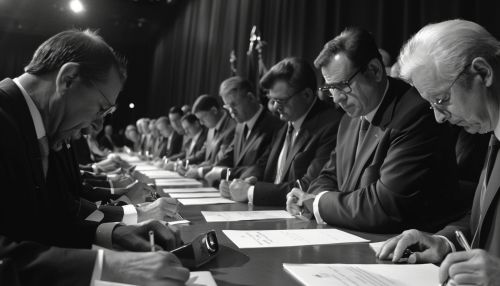Non-Proliferation Treaty (NPT): Difference between revisions
(Created page with "== Introduction == The '''Non-Proliferation Treaty (NPT)''', also known as the Treaty on the Non-Proliferation of Nuclear Weapons, is an international treaty aimed at preventing the spread of nuclear weapons and promoting peaceful uses of nuclear energy. The treaty was opened for signature on July 1, 1968, and entered into force on March 5, 1970. As of 2021, 191 countries are parties to the treaty, making it one of the most widely adhered to arms control agreements in hi...") |
No edit summary |
||
| Line 38: | Line 38: | ||
The future of the NPT depends on the ability of the international community to address its challenges and to adapt to new security dynamics. Strengthening the verification mechanisms, promoting disarmament, and ensuring the peaceful use of nuclear energy remain critical to the treaty's success. | The future of the NPT depends on the ability of the international community to address its challenges and to adapt to new security dynamics. Strengthening the verification mechanisms, promoting disarmament, and ensuring the peaceful use of nuclear energy remain critical to the treaty's success. | ||
[[Image:Detail-93153.jpg|thumb|center|Delegates signing the Non-Proliferation Treaty.|class=only_on_mobile]] | |||
[[Image:Detail-93154.jpg|thumb|center|Delegates signing the Non-Proliferation Treaty.|class=only_on_desktop]] | |||
== See Also == | == See Also == | ||
Latest revision as of 01:13, 22 June 2024
Introduction
The Non-Proliferation Treaty (NPT), also known as the Treaty on the Non-Proliferation of Nuclear Weapons, is an international treaty aimed at preventing the spread of nuclear weapons and promoting peaceful uses of nuclear energy. The treaty was opened for signature on July 1, 1968, and entered into force on March 5, 1970. As of 2021, 191 countries are parties to the treaty, making it one of the most widely adhered to arms control agreements in history.
Historical Context
The NPT emerged during the Cold War, a period marked by intense rivalry and nuclear arms race between the United States and the Soviet Union. The Cuban Missile Crisis of 1962 underscored the catastrophic potential of nuclear warfare, prompting international efforts to curb the proliferation of nuclear weapons. The treaty was negotiated by the Eighteen Nation Committee on Disarmament, a United Nations-sponsored forum.
Structure and Provisions
The NPT is structured around three main pillars: non-proliferation, disarmament, and peaceful use of nuclear energy.
Non-Proliferation
The non-proliferation pillar obligates non-nuclear-weapon states to forgo the development or acquisition of nuclear weapons. Nuclear-weapon states, defined as those that tested nuclear devices before January 1, 1967 (the United States, Soviet Union, United Kingdom, France, and China), agree not to transfer nuclear weapons or other nuclear explosive devices to any recipient.
Disarmament
The disarmament pillar commits all parties to pursue negotiations in good faith on effective measures relating to cessation of the nuclear arms race and to nuclear disarmament. Article VI of the treaty specifically calls for efforts towards general and complete disarmament under strict and effective international control.
Peaceful Use of Nuclear Energy
The peaceful use of nuclear energy pillar encourages cooperation in the field of peaceful nuclear technology and equal access to this technology for all parties, while ensuring that such cooperation does not lead to the proliferation of nuclear weapons.
Implementation and Compliance
The International Atomic Energy Agency (IAEA) plays a crucial role in the implementation of the NPT. The IAEA is responsible for verifying compliance through safeguards agreements, which include inspections and monitoring of nuclear facilities to ensure that nuclear materials are not diverted to weapons programs.
Challenges and Criticisms
Despite its broad acceptance, the NPT faces several challenges and criticisms.
Non-Signatory States
India, Pakistan, and Israel have never signed the NPT and have developed nuclear arsenals. North Korea withdrew from the treaty in 2003 and subsequently conducted nuclear tests.
Disarmament Concerns
Critics argue that the nuclear-weapon states have not made significant progress towards disarmament, as required by Article VI. The modernization of nuclear arsenals by these states is seen as contrary to the spirit of the treaty.
Peaceful Use and Dual-Use Technology
The spread of nuclear technology for peaceful purposes poses a proliferation risk due to the dual-use nature of nuclear technology, which can be used for both civilian and military applications.
Review Conferences
Review Conferences are held every five years to assess the implementation of the NPT and to address emerging challenges. These conferences provide a platform for states to reaffirm their commitments and to negotiate measures to strengthen the treaty.
Future Prospects
The future of the NPT depends on the ability of the international community to address its challenges and to adapt to new security dynamics. Strengthening the verification mechanisms, promoting disarmament, and ensuring the peaceful use of nuclear energy remain critical to the treaty's success.


